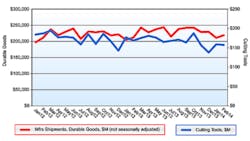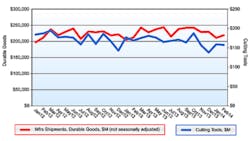In February, consumption of cutting tools by U.S. machine shops and other manufacturers slipped slightly from the January total — down 1.2%, from $158 million to a new total of $157 million — and more so from the year-ago result from February 2013. The new figure is 6.8% less than the total recorded for February 2013.
The results are drawn from the latest U.S. Cutting Tool Market Report, issued jointly by the U.S. Cutting Tool Institute and AMT – The Association For Manufacturing Technology.
The USCTR is a monthly report based on actual sale of cutting tool products, as reported by participating suppliers who represent about 80% of the domestic market for cutting tools.
“The trend is certainly on an upward climb as incoming orders have indicated a strong finish for the first quarter of the calendar year,” according to USCTI president Tom Haag.
The USCTR is a recently developed report that AMT and USCTI introduced less than a year ago, calling it their “first step” to promote and support domestic manufacturers of cutting tools. The lack of a long history of reporting makes it difficult to judge trends in the market.
However, the new result resumes a wavering sequence in the monthly reporting. While January totals indicated a robust improvement after two months of decline, it’s possible that the February report is an indicator of a short month and/or weather-impaired manufacturing activity.
About the Author
Robert Brooks
Content Director
Robert Brooks has been a business-to-business reporter, writer, editor, and columnist for more than 20 years, specializing in the primary metal and basic manufacturing industries.

